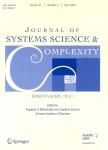DYNAMIC PRICE MODEL BASED ON TRANSMISSION DELAY——PETROLEUM PRICE FLUCTUATION IN CHINA
DYNAMIC PRICE MODEL BASED ON TRANSMISSION DELAY——PETROLEUM PRICE FLUCTUATION IN CHINA作者机构:Economics SchoolCentral University of Finance and Economics Research Center for Climate and Energy FinanceCUFE School of ManagementUniversity of Chinese Academy of Sciences China Development Bank
出 版 物:《Journal of Systems Science & Complexity》 (系统科学与复杂性学报(英文版))
年 卷 期:2014年第27卷第3期
页 面:507-523页
核心收录:
学科分类:0810[工学-信息与通信工程] 1205[管理学-图书情报与档案管理] 12[管理学] 120202[管理学-企业管理(含:财务管理、市场营销、人力资源管理)] 0202[经济学-应用经济学] 02[经济学] 1202[管理学-工商管理] 020205[经济学-产业经济学] 0811[工学-控制科学与工程] 0812[工学-计算机科学与技术(可授工学、理学学位)]
基 金:supported by the National Natural Science Foundation of China under Grant Nos.71003115 and 70903068 Collaborative Innovation Center,Research Innovation Team Supporting Plan of the Central University of Finance and Economics,Beijing Higher Education Young Elite Teacher Project under Grant No.YETP0964 the Ministry of Education of Humanities and Social Science Youth Fund Project under Grant No.11YJC790114
主 题:Directed weighted network input-output price model petroleum price transmission timedelay.
摘 要:Petroleum is a kind of fundamental energy resource. Its price fluctuation transmits from upper-stream industry to the lower-stream industry as the production factors price changes. And this leads to the price changes of final consumption. Meantime, due to the cycle of industrial chain, the price changes of lower-stream industry also affect the upper-stream industry in return. This price transmission path is quite complicated. Firstly, it includes both direct and indirect paths; secondly, the transmission process is accompanied with time delay. The traditional input-output price model based on cost-push theory can efficiently solve the first problem when estimating the impact of price fluctuation on the whole price system. However, it neither reflects the dynamic characteristics of price transmission with time nor solves the second problem. To solve this problem, this paper uses the directed weighted network to describe the price transmission among industrial sectors by taking the time-dimension into account, and dynamic price transmission network model is constructed. This model not only describes transmission time delay more accurately, but also calculates the price fluctuation dynamically. On this basis, by utilizing the 2007 Chinese input-output table, this paper conducts empirical analysis on the impact of petroleum price fluctuation on other sectors. The empirical results indicate that the price fluctuation transmission mainly depends on two factors, the orice reaction period Tk and the consumption relationship with petroleum aik. 1) If t 〈 Tk, then the price change of sector k at period t △pkt = 0, the petroleum price fluctuation has not transmitted to the sector k, so the price of sector k remains unchanged. 2) If t 〉 Tk, then Apt 〉 0, and the greater aik, the higher price change rate. 3) If t →∞, it is the same with that in traditional input-output price model. So it can be clearly seen that dynamic price transmission network model is more general than the t



